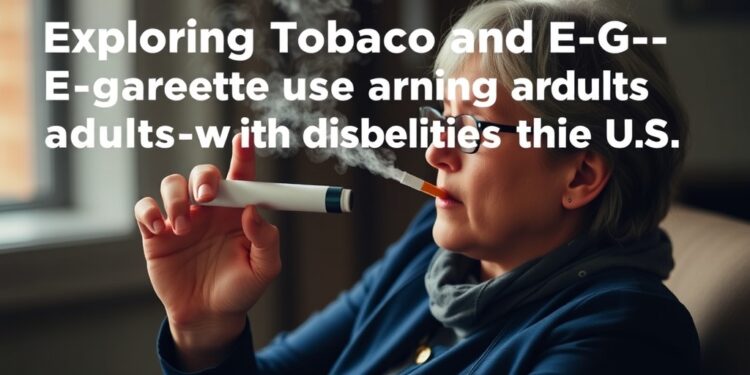In recent years, public health initiatives have made significant strides in reducing tobacco use among various populations. However, a new survey study reveals a concerning trend: disparities in tobacco usage persist across individuals with cumulative disabilities. This research underscores the urgent need for targeted interventions tailored to address the unique challenges faced by this demographic, particularly those with three or more disabilities. Despite a general decline in tobacco consumption, certain groups continue to be disproportionately affected, emphasizing the necessity for focused prevention and cessation efforts.
The study highlights the multifaceted nature of tobacco dependency, pointing out that those with multiple disabilities often encounter barriers to quitting. These barriers can include limited access to cessation programs, co-occurring mental health conditions, and a lack of tailored support systems. The persistence of tobacco use in this population not only threatens individual health but also exacerbates existing health disparities, leading to worsening outcomes for those with disabilities.
In an effort to combat these disparities, the researchers recommend a comprehensive approach that combines prevention, screening, and cessation strategies. This approach should encompass diverse tobacco products, acknowledging that individuals may use different forms of tobacco, such as e-cigarettes or smokeless tobacco. By incorporating various cessation methods, health practitioners can cater to the preferences and needs of individuals with disabilities, thus enhancing the likelihood of successful quitting.
Furthermore, the findings draw attention to the importance of including people with disabilities in public health discussions and initiatives. Historically, health policies have often overlooked the specific needs of this population, leading to gaps in care and support. By emphasizing the need for inclusion, the study advocates for a shift in how public health agencies design and implement tobacco control measures.
The research also reveals that individuals with disabilities face unique stressors that can influence their tobacco use. These stressors may include social isolation, difficulties in daily living tasks, and a lack of adaptive coping mechanisms. Addressing these underlying issues is crucial for creating a supportive environment that fosters healthy behaviors and reduces tobacco dependency.
In terms of public health messaging, the study suggests that campaigns should be designed with sensitivity to the experiences of individuals with disabilities. Messaging that resonates and is relatable can lead to higher engagement and participation rates in cessation programs. Tailoring messages to highlight the benefits of quitting, both for personal health and improved quality of life, can help motivate individuals in this vulnerable population.
Training healthcare providers to recognize and respond to the unique challenges faced by those with disabilities is another critical aspect of this research. Healthcare professionals must be equipped with the knowledge and tools to effectively support their patients in quitting tobacco. This includes understanding the unique barriers these individuals face and providing resources that are accessible and practical.
Ultimately, the study serves as a call to action for public health officials, researchers, and healthcare providers to prioritize targeted tobacco control initiatives for individuals with disabilities. By recognizing and addressing the disparities that exist in tobacco use among this population, stakeholders can work towards creating a more equitable healthcare landscape. This not only benefits those with disabilities but also aligns with broader public health goals of reducing tobacco-related morbidity and mortality.
As the research community continues to explore the dynamics of tobacco use, it becomes increasingly clear that a one-size-fits-all approach is insufficient. Tailored interventions that consider the diverse experiences and needs of individuals with disabilities are essential for fostering meaningful change. By investing in inclusive research and programming, society can pave the way for a healthier future for all individuals, regardless of their abilities.
The implications of this study extend beyond tobacco use alone. They highlight the interconnectedness of health, social justice, and disability rights. As we strive to achieve greater equity in public health, it is crucial to acknowledge and dismantle the systemic barriers that contribute to health disparities. Creating a healthcare system that values inclusivity and accessibility will not only improve outcomes for individuals with disabilities but will also enhance the overall health of society.
To facilitate these changes, collaboration between various sectors – including healthcare, education, and advocacy organizations – is necessary. By fostering partnerships aimed at promoting health equity for individuals with disabilities, we can cultivate an environment where everyone has the opportunity to lead healthy, fulfilling lives. It is through these collective efforts that we can hope to eradicate the disparities in tobacco use and promote a culture of health and wellness for all.
In conclusion, the disparities in tobacco use among individuals with disabilities exemplify the urgent need for targeted public health interventions. This study not only sheds light on the challenges faced by this population but also serves as a reminder of our collective responsibility to advocate for health equity. By implementing comprehensive programs, fostering inclusive messaging, and providing appropriate support, we can dismantle the barriers that perpetuate tobacco use among individuals with disabilities, ultimately working towards healthier communities.
Subject of Research: Disparities in tobacco use among individuals with disabilities
Article Title: Disparities in Tobacco Use Among Individuals with Cumulative Disabilities: A Call for Targeted Public Health Interventions
News Publication Date: Not specified
Web References: Not specified
References: Not specified
Image Credits: Not specified
Keywords: Tobacco use, disabilities, public health, prevention, cessation, health equity, tobacco control.
Tags: addressing health inequities in tobacco usebarriers to quitting tobacco for disabled individualscomprehensive tobacco prevention strategiesdiverse tobacco product usagee-cigarette usage in disabled populationshealth disparities in tobacco consumptionmental health and tobacco dependencypublic health initiatives for tobacco reductionsmoking cessation programs for disabled adultstailored support for smokers with disabilitiestargeted interventions for tobacco cessationtobacco use among adults with disabilities





